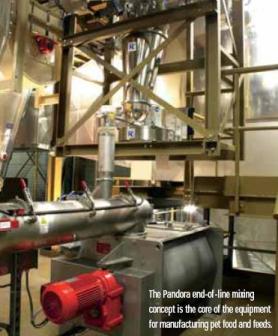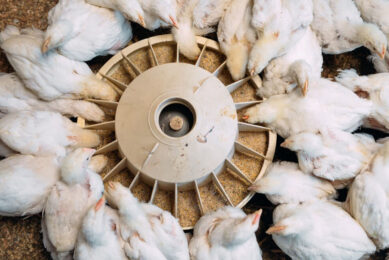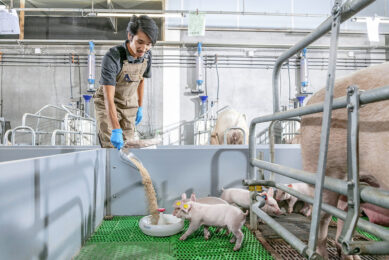Creating optimum feeder and mixer conditions for pet food

Feeding and mixing in a feed manufacturing process can be continuous or batch wise. A comparison is made for pet food manufacturers to be able to react to the demands in the market and be as flexible as possible, without compromising food quality.
In today’s growing pet and animal feed market, due to the extensive variety of breeds and feed requirements, it is necessary for the pet food/feed manufacturers to be able to provide a varied selection of food types and recipes.
It is therefore important that the manufacturing processes are flexible and efficient, easy to implement, and easy to clean. Most importantly, the product quality must be acceptable. All of these requirements are provided by the typical characteristics of a continuous mixing process with automated high accuracy feeding. This article will outline the technologies involved in the continuous mixing process, discuss the comparison between batch and continuous mixing, and will discuss a specific pet food example where the end user modified from a batch process.
Before describing a continuous mixing process with ultra precise feeding, let us summarise the benefits:
- High mix quality and final quality
- Minimum space requirement
- Quick cleaning
- Easy to control
- Simplified process sequence
- High throughput capacity
- Gentle mixing due to short material dwell time
- Low energy consumption
- Reduced risk of demixing.
To prove these statements, the two main players, the feeder and the mixer, will first be described individually and then in the context of their interaction.
Volumetric versus gravimetric feeding
The core of the equipment for manufacturing pet food and feeds is the mixer (see photo). The additives are dosed proportionally to the extruder performance. This is performed by a K-Tron gravimetric screw feeder. As will be explained later, the feeding precision and the operation of the screw feeder is a key factor in this process.
Volumetric feeders operate by delivering a certain volume of material per unit time. Flow rate changes are accomplished by altering screw speed. In the case of a screw feeder, three factors affect volumetric screw feeder accuracy:
- the consistency of delivered volume per screw revolution,
- the accuracy of screw speed control, and
- material density variability.
Typically, volumetric feeders are open-loop devices in that they cannot detect or adjust to variations in the material’s density. Due to the open loop concept, head load variations and material build up on the feed device change the volume per revolution relationship, throwing off calibration at any sign. Gravimetric feeders however, automatically detect and adjust to these conditions. For this reason, they are the feeder technology imperative for continuous operations.
Loss in weight principle
The most popular type of gravimetric feeder used is the loss-in-weight (LIW) feeder. Loss-in-weight feeders directly measure and control the process variable of flow rate and can fully contain the material within the confines of the feeder. LIW feeders are typically either mounted on weigh scales or suspended from load cells. A LIW feeder consists of a hopper and feeder that are isolated from the process so the entire system can be continuously weighed. As the feeder discharges material, system weight declines, the speed of the metering device is controlled to result in a per-unit-time loss of system weight equal to the desired feed rate or set point. A typical LIW feeder controller adjusts feeder speed to product a rate of weight loss equal to the desired feed rate set point.
A high feeding precision is achieved by:
- Rotational speed control of the feeding screws that is dependent on the feeding performance
- Efficient elimination of disturbance variables
- A sophisticated refill process of the feeding scale without a negative influence on the feeding precision
- A high-resolution weighing system.
To be able to guarantee the required feeding performance in the tolerance range with a very high sampling rate, a digital weighing system according to the vibrating wire technology is used. This sampling rate includes a frequency of 112 measurements per second and a resolution of 1:4,000,000. In addition, a newly developed filter technology with real-time calculation is used.
Feeding precision
The K-Tron feeding scale controller, or KCM, is equipped with electronic rotational speed modulation. In this way, the pulse arising from the ejection from the double screws is electronically compensated. High feeding constancy is therefore achieved, even at extremely low feed rates, which are sometimes required for minor and micro additives to the mixer, such as flavours or vitamins.
Although we have talked about high feeding precision, we should also explain how this is defined. The precision is described according to three factors:
- Feeding constancy S (spread of the feeding flow samples around the sample average)
- Short-term precision
- Long-term precision (deviation of the sample average from the target value).
To determine the feeding precision, for example, the discharged product quantity at 5-second intervals is recorded over a measuring time of 30 minutes by a reference scale. The process is repeated at 60-second intervals. After recording all of the measurements, the two sigma values for the 5 and 60-second samples are calculated according to the normal (Gaussian) distribution. (Figure 1). The evaluation of the 60-second sample time basis corresponds to the definition of the feeding precision according to NAMUR (Interest group for automation technology in the process industry).
For the sigma calculation, the following relationship applies:
For accuracy requirements in the 1-5 percent range, volumetric feeders may suffice. However, for the consistent and accurate required short term accuracies of 0.25 to 1 percent for a continuous process, the gravimetric feeder technology is essential.
The mixing technology
The example on the photo uses a continuous mixer from the company Dinissen. It is a counter-rotating double-shaft paddle mixer. These counter rotating shafts contribute to the intense mixing effect necessary for the shorter residence time, continuous mixing process.Exactly what is so special about this continuous mixing process? In brief, the ingredients of the formulation must be mixed together uniformly in the shortest possible time. Uniformly means, among other things, that a mix sample is representative of the entire continuous mixture. Since the mixing process runs continuously, this uniformity must be guaranteed to be achieved during the process time. Due to detailed test series, reliable statements can be made regarding the mix quality in each time unit. In our described application, two bulk goods enter the mixer in the correct ratio simultaneously and in parallel. It is precisely these characteristics that permit the compact construction of the mixer and the short process time of approx. 30 seconds.Some more theory: The mixer differentiates between longitudinal and transverse mixing. Longitudinal mixing describes the mixing together of materials entering at different times, and transverse mixing describes the mixing together of materials entering simultaneously. Since this system consists of the feeder and mixer components which are adjusted to each other, as described in the next section, optimal conditions arise in this case
Feeding and mixing technology combined
The diagram in Figure 2shows the feeder and mixer in the above-mentioned application example. To ensure that this combined action also occurs optimally in reality, the companies K-Tron and Dinnissen have jointly developed the Pandora end-of-line mixing concept, which provides a complete and integrated control and feedback system for optimal mixing. With this concept, up to five components can be mixed quickly, safely, homogeneously, and continuously within a small space.
The special feature of such processes is the short mixing times. For example, sticky powders or hard to mix powders and fluids become homogeneous in 30 to 50 seconds. The Pandora end-of-line mixing concept is particularly suitable for the spraying of powders, pellets and granulates with oils and fluids. All of these scenarios are required for different pet food and feed recipes. Even in a well-maintained process, there are interruptions from time to time. It is therefore very important how quickly the feeding can reach the target value again. With this system, this reaction time and adjustment back to set point is as low as 2 seconds.When starting up the process, the typical filling time of the mixer is less than 30 seconds. A constant mixing quality is achieved after approx. 1 to 2 minutes.In the case of this specific pet food example, the main component moves directly from the extruder into the mixer. As mentioned initially, the additives, such as flavourings and vitamins, are fed in proportion to the extruder performance, at lower feed rates, by additional K-Tron gravimetric feeders. The decisive factor for ensuring high quality is the immediate reaction of the K-Tron feeding balance weighing system.
Continuous process or batch process
In the case of the continuous mixer, a much shorter mixing time with a much smaller overall volume of mix is utilised. In the batch process with a relatively large mixer, longer transport routes often occur after discharge. This results in the risk of demixing or even contamination. The mixed goods are also used more intensively.This is not the case for a compact, continuously running mixer, which in most cases can be installed directly in front of the next system component, e.g. an extruder. No losses of the mixed goods also occur in the case of small interruptions. In addition, much tighter control of the ingredients introduced to the mixer can be achieved, through the use of high accuracy K-Tron feeders. This not only improves overall product quality, but it also can result in significant cost savings for overall ingredient costs.
Summary
There are a number of significant advantages of conversion from the batch mixing process to a continuous process with high accuracy feeding. In the case of this specific pet food manufacturer, the conversion allowed him to operate the entire process in a much shorter timeframe, with improved product end quality. In addition, the highly engineered system designed by the K-Tron and Dinissen project engineers also included easy clean and ergonomic equipment and layout designs, thus allowing for a very flexible system during product changeover. This increase in flexibility also contributed to a much more efficient process.











